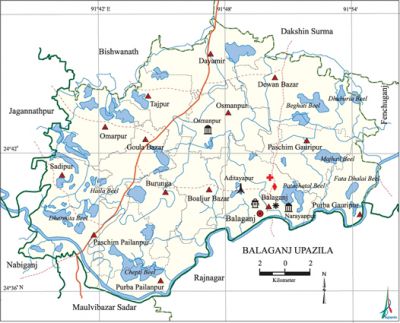Balaganj Upazila
Balaganj Upazila (sylhet district) area 389.51 sq km, located in between 24°36' and 24°47' north latitudes and in between 91°38' and 91°56' east longitudes. It is bounded by dakshin surma and bishwanath upazilas on the north, rajnagar and maulvibazar sadar upazilas on the south, fenchuganj upazila on the east, Bishwanath, jagannathpur and nabiganj upazilas on the west.
Population Total 256239; male 130607, female 125632; Muslim 232921, Hindu 23158, Buddhist 43, Christian 9 and others 108.
Water bodies Main river: kushiyara; Haila beel, Chepti beel, Kery beel, Karcha beel, Majail beel, Dhalai beel, Dhuburia beel and Beghati beel are notable.
Administration Balaganj Thana was formed on 10 January 1922 and it was turned into an upazila in 1983.'
| Upazila | ||||||||
| Municipality | Union | Mouza | Village | Population | Density (per sq km) | Literacy rate (%) | ||
| Urban | Rural | Urban | Rural | |||||
| - | 14 | 241 | 471 | 5643 | 250596 | 658 | 54.42 | 47.70 |
| Upazila Town | ||||||||
|
Area (sq km) |
Mouza |
Population |
Density |
Literacy rate (%) | ||||
|
4.41 |
2 |
5643 |
1280 |
54.42 | ||||
| Union | ||||
| Name of union and GO code | Area (acre) | Population | Literacy rate (%) | |
| Male | Female | |||
|
Omarpur 51 |
7847 |
10095 |
9398 |
45.82 |
|
Osmanpur 55 |
7757 |
12920 |
12793 |
50.52 |
|
Goula Bazar 40 |
4563 |
9558 |
8689 |
48.74 |
|
Tajpur 88 |
5820 |
10866 |
10198 |
48.69 |
|
Dayamir 27 |
7988 |
12686 |
12238 |
55.85 |
|
Dewan Bazar 33 |
10976 |
13516 |
13160 |
51.69 |
|
Paschim Gauripur 60 |
6190 |
5481 |
5557 |
46.19 |
|
Paschim Pailanpur 64 |
5164 |
5811 |
5640 |
42.16 |
|
Purba Gauripur 70 |
4686 |
6792 |
6724 |
49.40 |
|
Purba Pailanpur 67 |
5094 |
4980 |
4892 |
39.17 |
|
Balaganj 06 |
7974 |
10998 |
10400 |
45.09 |
|
Burunga 20 |
4583 |
7136 |
6658 |
40.42 |
|
Boaljur Bazar 13 |
5834 |
7443 |
7279 |
49.87 |
|
Sadipur 81 |
10554 |
12325 |
12006 |
44.15 |
Source Bangladesh Population Census 2001, Bangladesh Bureau of Statistics.

Archaeological heritage and relics Akhra of Gauranga Mahaprabhu, remnants of Nagendra Das Chowdhury's residence, Temple of Chandranath Sharma (Babnobazar).
History of the War of Liberation During the war of liberation in 1971 the Pak army brutally killed many people of the upazila; they also plundered and set many houses on fire. On 6 May the Pak army committed mass killing at Ilashpur and they also killed 36 persons at Adatyapur. There were two serious encounters between the Pak army and the freedom fighters at Sherpur and Sadipur resulting in the defeat of the Pak army.'
Marks of the War of Liberation Mass grave 4 (Adityapur, Burunga, Bhatpara, Salimpur), memorial monument 1.
Religious institutions Mosque 440, temple 6. Noted religious institutions: Osmanpur Jami Mosque, Baitul Moazzem Jami Mosque (Goalabazar), Harinagar Shiva Temple, Nishikantadev Brahmachari Temple, tombs of Shah Tazuddin, Fakir Kanai Shah, Katali Shah (Sherpur), Sayed Usman Bogdadi (R), Narain Shah.'
Literacy rate and educational institutions Average literacy 47.85%; male 50.02%, female 45.19%. Educational institutions: college 5, secondary school 25, primary school 143, community school 27, madrasa 20. Noted educational institutions: Sharat Sunduri High School (1886), Mangal Chandi Nishikanta High School (1887), Nabagram Hazi Md. Saim High School (1928), Sadrunnesa High School (1929).
Newspapers and periodicals Weekly: Balaganj Barta.
Cultural organisations Library 1, club 27, auditorium 1.
Tourist spot' Paternal home of Bangabir MAG Osmani at Dayamir.
Main sources of income Agriculture 49.61%, non-agricultural labourer 5.10%, commerce 11.09%, transport and communication 2.93%, industry 0.59%, service 4.23%, construction 1.61%, religious service 0.56%, rent and remittance 11.52% and others 12.76%.
Ownership of agricultural land Landowner 42.34%, landless 57.66%; agricultural landowner: urban 37.19% and rural 42.47%.
Main crops Paddy, mustard seed, potato.
Extinct or nearly extinct crops Tobacco, mashkalai.
Main fruits Mango, jackfruit, coconut.
Fisheries, dairies and poultries This upazila has a number of fisheries, dairies and poultries.'
Communication facilities Pucca road 189.34 km, mud road 372.81 km.
Extinct or nearly extinct traditional transport Palanquin.
Cottage industries Nakshi pati, Shital pati, bamboo work, cane work.
Noted Hats, bazars and fairs Balaganj Bazar, Goala Bazar, Tajpur Bazar, Dayamir Bazar, Khaler Mukh Hat and Ghior Khal Mela.
Main exports Nakshi Pati, fish.
Access to electricity All the unions of the upazila are under rural electrification net-work. However 33.03% dwellings have access to electricity.
Sources of drinking water Tube-well 45.57%, tap 2.13%, pond 44.51% and others 7.79%. The presence of intolerable level of arsenic has been detected in the tube well water of the upazila.
Sanitation '45.60% (urban 59.15% and rural 45.25%) of dwelling households of the upazila use sanitary latrines and 43.35% (urban 30.44% and rural 43.69%) of dwelling households use non-sanitary latrines; 11.05% of households do not have latrine facilities.
Health centres Upazila health centre 1, satellite clinic 2, union health and family welfare centre 6, family planning centre 7, community clinic 23, private clinic 8, veterinary hospital 4.
NGO activities brac, CARE. [Mahiuddin Shiru]
References Bangladesh Population Census 2001, Bangladesh Bureau of Statistics; Cultural survey report of Balaganj Upazila 2007.
